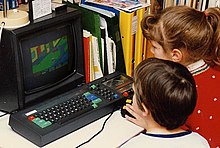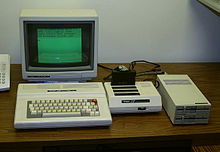
Back Heimcomputer ALS Ordinador domestico AN حاسوب منزلي Arabic Хатні камп’ютар Byelorussian হোম কম্পিউটার Bengali/Bangla Ordinador domèstic Catalan Domácí počítač Czech Hjemmecomputer Danish Heimcomputer German Computadora doméstica Spanish



Home computers were a class of microcomputers that entered the market in 1977 and became common during the 1980s. They were marketed to consumers as affordable and accessible computers that, for the first time, were intended for the use of a single, non-technical user. These computers were a distinct market segment that typically cost much less than business, scientific, or engineering-oriented computers of the time, such as those running CP/M or the IBM PC,[2] and were generally less powerful in terms of memory and expandability. However, a home computer often had better graphics and sound than contemporary business computers. Their most common uses were word processing, playing video games, and programming.
Home computers were usually sold already manufactured in stylish metal or plastic enclosures. However, some home computers also came as commercial electronic kits, like the Sinclair ZX80, which were both home and home-built computers since the purchaser could assemble the unit from a kit.
Advertisements in the popular press for early home computers were rife with possibilities for their practical use in the home, from cataloging recipes to personal finance to home automation,[3][4][5] but these were seldom realized in practice. For example, using a typical 1980s home computer as a home automation appliance would require the computer to be kept powered on at all times and dedicated to this task. Personal finance and database use required tedious data entry.
By contrast, advertisements in the specialty computer press often simply listed specifications, assuming a knowledgeable user who already had applications in mind.[6][7] If no packaged software was available for a particular application, the home computer user could program one—provided they had invested the requisite hours to learn computer programming, as well as the idiosyncrasies of their system.[8][9] Since most systems arrived with the BASIC programming language included on the system ROM, it was easy for users to get started creating their own simple applications. Many users found programming to be a fun and rewarding experience, and an excellent introduction to the world of digital technology.[10]
The line between 'business' and 'home' computer market segments vanished completely once IBM PC compatibles became commonly used in the home, since now both categories of computers typically use the same processor architectures, peripherals, operating systems, and applications. Often, the only difference may be the sales outlet through which they are purchased. Another change from the home computer era is that the once-common endeavor of writing one's own software programs has almost vanished from home computer use.[11][12]
- ^ "Most Important Companies". Byte. September 1995. Archived from the original on 2008-06-18. Retrieved 2019-11-04.
- ^ "IBM PC turns 25". CNN.
Several popular home computers existed before the 1981 IBM PC launch. But the regimented business world considered Apple, Commodore, and Radio Shack's Tandy products "toys."
- ^ Video of old TV Ad for Atari Home computers from YouTube Archived January 30, 2014, at the Wayback Machine
- ^ "Home computer ads". Wotsit.thingy.com. 2001-02-05. Retrieved 2013-04-09.
- ^ "The Old Computer - Retro TV Commercials, Old Computer Commercials, computer adverts". www.theoldcomputer.com.
- ^ "May 1982 VIC-20 ad".
- ^ "Franklin ACE2000 ad". Archived from the original on 2020-08-01. Retrieved 2013-01-12.
- ^ "The Golden Age of Basic". Archived from the original on May 3, 2014.
Let's not kid ourselves in a haze of nostalgia—there are very good reasons why things like Scratch and Processing were created, the same reasons why many, if not most, of those 8-bit machines wound up being used solely to play games. Tapping out Basic programs often meant a lot of effort with nothing to show for it other than that Great Sphinx of computer messages: "SYNTAX ERROR."
- ^ "Fifty Years of BASIC, the Programming Language That Made Computers Personal". 29 April 2014.
- ^ "CNN.com readers recall the life-changing Commodore 64". CNN. Retrieved 22 May 2016.
- ^ Jeremy Reimer (December 2005). "Personal Computer Market Share: 1975–2004". Ars Technica. Archived from the original on June 6, 2012. Retrieved 2008-02-13.
- ^ David Brin (14 September 2006). "Why Johnny can't code". Retrieved 2013-04-09.